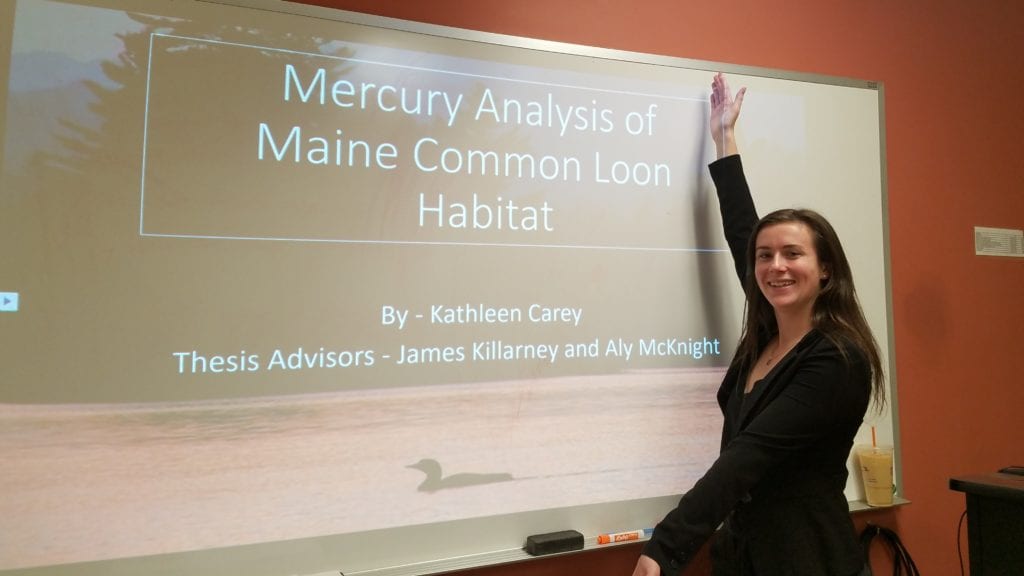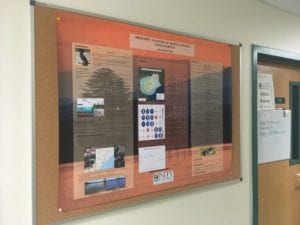
“I want to be an environmentalist,” 10-year old me told my family. They laughed and didn’t really understand what I meant, but now I’m graduating college in a semester with a double major in Wildlife Biology and Wildlife Management.
I grew up in a populated town in Delaware where both my parents and brother graduated from University of Delaware, and with no one in my family in a biology field. My high school didn’t offer many environmental classes, therefore I was clueless to a lot of things that Mainers grow up learning. I had never hunted or even held a gun, I never saw any large mammal in the wild other than white-tailed deer, and I couldn’t even distinguish a deciduous tree from a coniferous tree. I got interested in this field because I started learning about climate change. It was this big, scary thing effecting everyone around the world. When I was looking at colleges, I decided that I wanted to go into a field that would make an important change in the world, and that’s when I started doing research and found this field of study.
I went to Unity College because it focused on the environment and was a tight-knit community of people with a lot of the same agendas. Being surrounded by friends that were just as passionate as me really helped me grow as a person and helped me gain experience with all things wildlife related. Before the freshmen year started, every freshman goes on a NOVA trip which is a week-long orientation camping in various areas of Maine. My trip went to Lake Nahmakanta in the North Maine Woods. One day everyone freaked out and pointed across the lake at a Common Loon. I didn’t know what the heck they were talking about, so I just acted surprised. Fast forward to my junior year of college and I took an Environment Chemistry class because it sounded very relatable to climate change. That class got me concerned about heavy metal toxins, pesticides, and other chemicals that are getting into the environment because of humans. The class did a group project on Unity Pond and one day we were driving there and my friend pointed to the Maine wildlife license and said, “Look at that checkered chicken!” He then went on to explain to me that in the backwoods they call Common Loons checkered chickens. This was funny and intriguing. I did my own research and the next semester in my Thesis 1 class I decided to study the relationship between Common Loons and mercury poisoning.
Over the summer between my Thesis 1 and Thesis 2 class, I got the opportunity to intern for Maine Audubon. This was exciting because I worked on organizing data for the Annual Loon Count and I even got to work a booth on their Peony Day. The booth allowed me to interact with the public on issues surrounding the conservation of the Common Loon population in Maine. Being able to talk to the public and see that most were just as passionate as me about these issues made me overwhelmingly happy. The internship allowed me to work with people with similar goals in mind and it absolutely increased my drive to stick to my thesis topic and hopefully one day work in the field with loons.

Just like my widespread interest in fields surrounding climate change, my thesis ended up evolving into something that utilized a variety of methods. I decided to incorporate ArcGIS because, upon entering Unity College, I learned how important the program was. Another system I used was the R-statistics program, which I first found out about through one of my classes. I knew I wanted to show correlations between several variables, so when I looked up “Multiple correlation analyses in R” on Youtube, I was able to find a method that could be easily presented to the public. Once I gathered my data, I was able to follow along with the tutorial. The last method I used was the Data Analysis toolbox in Excel to calculate an F-ANOVA test, a method used to look at both correlation and regression between two datasets.
This was my first time doing independent research. I went into this nervous and lost, but thankfully I had professors and friends help me through the whole process. I spent two nights and three days over the summer of 2018 collecting lake sediment samples from 10 lakes across Maine, driving a total of over 300 miles and spending a lot of my own money along the way. I wanted to test the sediment for total mercury so that I could show the biomagnification of mercury (specifically methylmercury) from an abiotic factor to a biotic factor such as the Common Loon. I had data from the Biodiversity Research Institute on the blood mercury levels of loons at these lakes already. It turned out that it was $50 a lab sample to test sediment for mercury, and I was given $500 from a Unity College award. The financial aspect was my first reality check.
The next was getting lost on a logging dirt road trying to find this inlet public boating access near Flagstaff Lake. I was on this road for over 30 miles with no way of turning around, blindly following coordinates I found online. It wasn’t the best day of the trip, but I did find the lake access point and I’m glad I did because that sample ended up being very important to my results. The first night I spent money on a hotel and the next night I slept in a cabin near Bethel that my thesis advisor owned. I spent more money than expected, I missed deadlines, and there were points where I didn’t even think I could finish my thesis because I was running out of time. But let me tell you, it was worth it.
At the end of the semester I presented my defense and having all my friends show up to support me meant so much. At the Unity College Student Conference, I ended up winning the Award for Academic Excellence for my thesis. This experience has increased my drive and passion even more towards making a positive change to the environment, and I’m not slowing down anytime soon.
Now I can look back at 10-year old me and say, “You’re on your way.”
